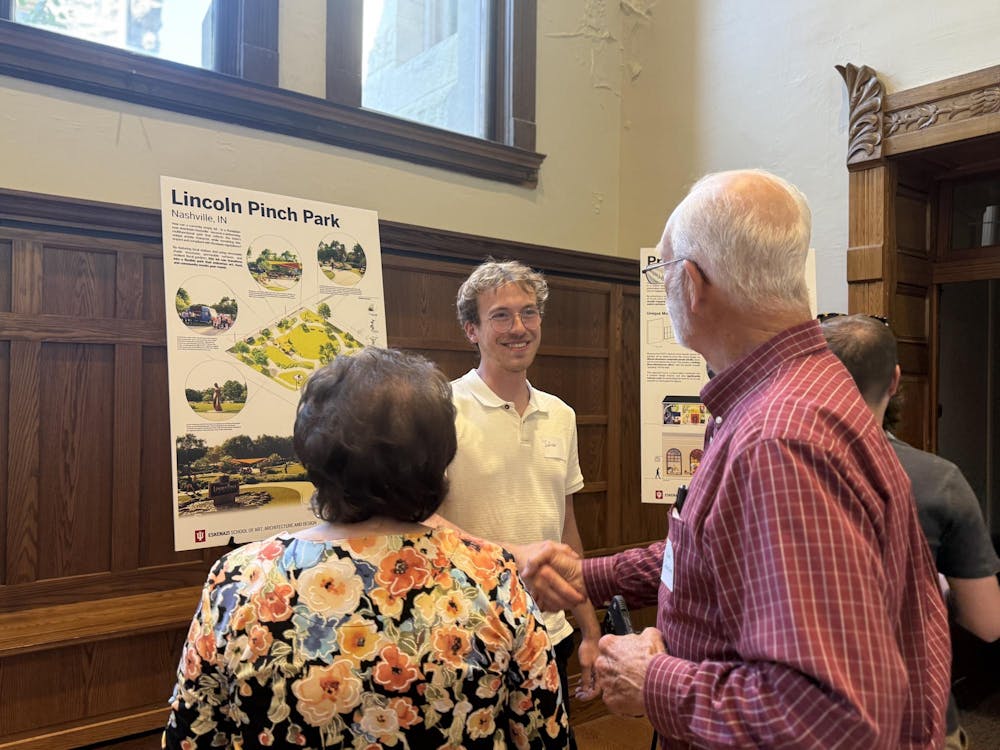Source: Indiana Daily Student
What used to be blank walls and empty spaces are now filled with murals, parklets and public art.
On Thursday, students and community members alike celebrated the completion of a collaborative placemaking art and design project that transformed rural downtowns across south and central Indiana at IU’s Rural Placemaking Studio Open House.
The open house, held from 5-7 p.m., featured design boards displaying projects from each of the 16 participating counties. Students stood by their boards to walk guests through the creative process, while community representatives gathered to discuss how the work had impacted their towns.
The celebration marked the culmination of the 2025 Rural Placemaking Studio initiative, a partnership between the IU ServeDesign center at IU’s Eskenazi School of Art, Architecture and Design and the IU Center for Rural Engagement. The project connects university faculty and students with rural communities to enhance public spaces through art and design, including wayfinding signage and public art installations.
Tracy Brown-Salsman, a Martin County resident, praised the students’ work on historical buildings.
“It turned out just beautiful,” he said. “We’re very impressed with the work the students did with our community in Martin County, and it looks like they did beautiful work for the other communities.”
Jon Racek, program director of comprehensive design at Eskenazi and director of the ServeDesign Center, said that the project is run like a professional design firm.
“The faculty are the design partners, and the students are the ones managing each project,” Racek said.
The 2025 program represents an expansion from the previous year, growing from 13 to 16 participating communities. The initiative focuses on rural communities with populations of 50,000 or fewer within approximately 90 miles of Bloomington, targeting areas that often lack resources for professional design services.
“Sometimes we act as just a catalyst for getting projects going,” Racek said. “Our goal is to hand it back to them with a design they can show to the rest of the community, to professionals, and even use for grants or capital campaigns.”
Projects completed this summer span multiple counties and include diverse community enhancement efforts. The artwork includes parklets, or small seating areas in parking lots, historical signage celebrating local heritage, pre-architectural designs for community centers and murals that activate underutilized downtown spaces.
For students like Julian Clensy, an IU senior in comprehensive design, the experience offered hands-on learning.
“Talking with the people and getting their opinions on the designs was the most fun part for me,” he said. “It helped me learn how to work on human-centered designs for real people.”
The program received significant industry improvements this year through HWC Engineering’s $100,000 pledge supporting student engagement. The multi-disciplinary firm, which serves public and private clients across Indiana through economic development, planning, landscape architecture and other services, recognized the program’s dual benefit to students and communities.
“The heart of it is creating a place where people feel at home, have a sense of identity and pride where they live,” Hoosier Quality of Place Liaison with the IU Center for Rural Engagement, Nicole Vasconi said.
As part of her role, Vasconi serves as a collaborator and co-director of the Placemaking Studio, handling logistics, scheduling and applications behind the scenes.
“A big part of the process is leading the community engagement sessions and community planning sessions,” Vasconi said. “We make sure the project is not just one person’s idea, but there has really been consensus around it and drive within the community to see it through.”
That emphasis on collaboration carried through to the students experience in the field.
“I hope the projects create spaces where communities can gather and connect,” Clensy said. “If you want to learn how to work with real people, with real clients, then do it. You get good real-life experience.”
A further call for proposals, inviting communities to submit projects for consideration, is planned for winter 2025.
“We’ve got more projects that we would like to work on,” Brown-Salsman said. “This is just the beginning.”


